
A Rainy Day in Cape Town’s ‘Sun’ Township
When we began doing research for the South Africa portion of our trip we found a lot of information about township tours. After our amazing experience touring Dharavi in Mumbai we knew we wanted to include some kind of township visit into our stay. The most famous and widely visited is a township called Soweto, just outside of downtown Johannesburg…although that’s not the one we decided to visit.
Instead we followed the recommendation of our amazing Cape Town backpacker, The B.I.G. (stay there!!), and booked a tour to visit Langa Township. I know that there are some people out there who aren’t super keen to go on one of these tours, but I can assure you if you skip it you’ll only be doing yourself an injustice. Our day spent in Langa was a highlight of our trip and I have a feeling it will hold strong in the top five.
The morning of our tour we were picked up by Chippa Mngangwawho, I can say, without irony or exaggeration, is one of the happiest people I’ve ever met. Chippa founded Imivuyo Tours (which of course means happiness in Xhosa) and provides insightful and meaningful tours not only through Langa, but also through other parts of the city. Being the low season we got lucky and had him and the tour all to ourselves. As we piled into the van he immediately began sharing some history to help us better understand the neighborhood we were headed into.
Langa, which means ‘sun’ in Xhosa, got its name from Langalibalele, a chief and renowned rainmaker who was imprisoned on Robben Island in 1873. According to Wikipedia:
Langa was originally designed in a way to allow the authorities maximum visibility and control of residents […] however, close living conditions of residents in Langa promoted a high degree of neighborliness and the creation of broader African institutions that promoted a greater sense of community cohesion. On the 30 March 1960 Langa was the starting point for a march of 30,000 – 50,000 protesters to Nyanga police station led by Pan Africanist Congress to protest the hated Apartheid era pass laws.
We began our tour at the Guga Sthebe Arts & Culture Centre where we were able to learn about the many community art projects. Here local artists take on groups of children (ages 6-18) to teach them craft skills from pottery to painting. These projects are used to not only keep the kids safer and off the streets, but also to help teach them a trade that they can use to help support their families.

The community center had their own pottery studio with two kilns. The pottery they produce can be found at markets all over South Africa.
We loved all of the pieces and enjoyed the stress-free atmosphere of the shops set up at the entrance. One of the potters explained that most of their sales are made to market vendors and large companies (mostly universities looking for commemorative pieces) so there is no need to pressure the visitors. The relaxed environment provided us with the opportunity to learn more about the youth programs and the techniques, but also about the artists themselves.

It was fascinating to learn how these paintings were made. It was a multi-step process involving paint, sand and markers.
We also stumbled upon a presentation being made by the Triangle Project. They work to empower LGBT youth in the township and provide them with a safe and supportive environment to learn about their rights and available resources. We were happy to learn, and at the same time embarrassed by our own country’s policies, that the South African constitution forbids discrimination based on sexual orientation. We wanted to stay and listen to the whole presentation, but we had much more to see.
A big portion of the tour is visiting homes and we got to visit four examples that demonstrated the true economic diversity among the township residents. First we were taken to a block of ‘houses’ made of shipping containers. As we approached I was amazed that each one could fit a family and then shocked to find out that they were each divided into two homes.
At first I felt a little wary of going inside, wasn’t it rude? This is always my hang up on tours like these. Wasn’t it the manifestation of ‘white privilege’ to show up at these peoples’ doors and essentially say “wow, you’re so poor, can I take a picture to show all of my friends back home”…or is my guilt the real manifestation? I reminded myself that one of the biggest reasons we travel is to learn about how other people live and if they are kind enough to invite us into their homes then we should just appreciate their generosity.
So, yuppie guilt aside, we headed in. The first family we met was a mother and her four children. They all lived in this tiny space:
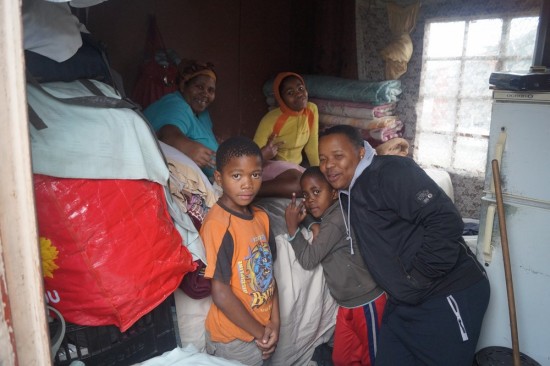
This family of five (not including Chippa who couldn’t resist photo bombing plus one son not pictured) all live in this tiny half of a shipping container. On this left side is one full size bed, along with everything they own.
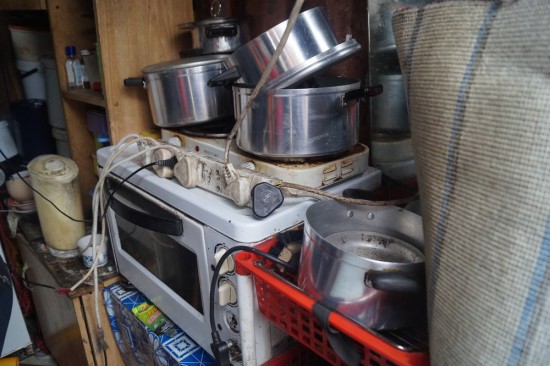
On the right was their kitchen. When I asked about house fires we were not surprised to hear that they were very common.
I couldn’t get over it. It would be one thing if Cape Town was a place with pleasant weather all year long so that the majority of living could be done outside, but it experiences a pretty good four season rotation and on days like today the rain kept most people inside. Just as I was thinking that it must be so hard in the cold and the rain I remembered that we were inside of a non-insulated metal can, and shuddered at the thought of hot sunny days. Chippa explained that this family had been on the list to be moved into one of the new apartments in the township, but their spot kept getting stolen. Apparently it was common for people to have their spots taken, either as a result of dishonest neighbors stealing their identity or good old fashion government corruption. Either way, this family was still waiting and would apparently be waiting for a while.

Long Street is the main drag of bars in Cape Town and this alley was jokingly referred to as the ‘Long Street’ of Langa

It was quite cold that day so fires were lit inside of the bars. It helped warm things up but created a ton of smoke.
Next we headed for the ‘Long Street’ of Langa. This row was where most of the township’s bars could be found. Run by women and patronized by men, these dark, smoky rooms served up the local beer, Umqombothi (I still cant pronounce it). The relatively weak drink (about 3%) is made from maize (corn), maize malt, sorghum malt, yeast and water. It’s apparently very rich in Vitamin B and has a slightly lighter and sourer (I checked and that is a word) flavor than typical beers we’re used to. Purchased by the bucket for about $1 and then passed around it is a favorite among the locals. We took our seats among the other patrons and Chippa demonstrated the proper technique – blow, tilt and sip. While I am not a huge fan of beer to begin with I never pass up an opportunity to try something new. I was actually surprised by how good it was, although I still don’t think I could enjoy a pint on my own.
After our beer break we moved onto the ‘nicer’ apartment blocks. Again I thought, ‘Well at least this is better. It might still be tight but they have insulation, indoor plumbing and a little more room.’ Again my preconceived notions we demolished when we entered the apartment. We were lead through a common area and into a bedroom cramped with three beds and a spattering of personal belongings ranging from clothes to cookware. Similar to the first home I was shocked by the electrical setup and couldn’t help but worry about the fire hazard. Just as I was thinking that it was tighter than I had originally imagined Chippa informed us that each bed area was home to a family…an entire family! So three families shared this tiny living space. He told us that the same was true of the other bedrooms. That was also when he informed us that this was the type of housing he grew up in.

This lovely woman was kind enough to let us into her home. This photo shows her family’s living area (1 of 3 in this tiny room).
All I could do was stare around the room. I tried to imagine what it must be like when everyone was home and couldn’t wrap my brain around it. With just us it was unpleasant, so I couldn’t imagine tripling the number. It was just another reminder of our need to reevaluate how much space we actually needed to be happy.

This woman was hilarious and stopped me to insist that I take her picture. She was dressed to the nines and made me look like a scrub.

It was very interesting to see the creative ways the storage containers were used. Any shop you could imagine was housed in one.
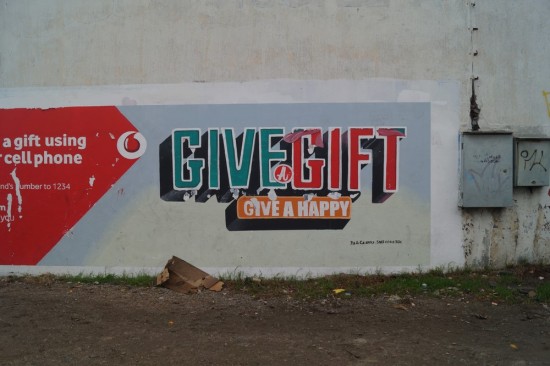
One of the most interesting things in the township, even among the poorest residents, was the number of mobile phones. Similar to Dharavi nearly everyone had one and in most cases they had two.
It was getting late in the morning but we had one more stop to make before lunch. As a result of overcrowding in the township and an influx of immigrants a large number of illegal houses had been built along the outskirts of town, wedged between the township border and the highway. This shanty village reminded us of Dharavi, although a lot more spread out. If I’m being perfectly honest, this section of town was what I thought the whole township would look like. I hadn’t realized before arriving that it was basically its own self-sufficient city, with schools, shops, a police station and hospital. In an effort to remove these illegal structures and provide better housing, the government was in the process of building brand new apartment blocks where the residents would be transferred. The buildings looked really nice on the outside, but I skeptically wondered how many people would actually get to take advantage of their designated spots. (Update: The locals apparently shared this skepticism and on July 9th violent protests broke out in the township)
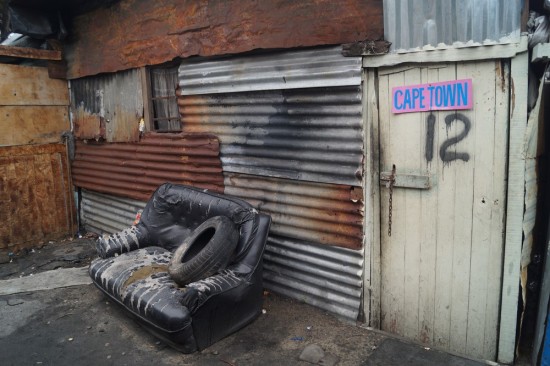
It seemed like we were 1,000 miles away from the Cape Town we had first been introduced to, but we appreciated the opportunity to be exposed to this side of the city.
For lunch it was time to move onto the ‘Beverly Hills’ of the township (Chippa’s title). This part of town really looked like it could fit in anywhere. Mid-size ranch bungalows were set along organized streets on manicured lawns. He proudly proclaimed that this was where he lived. I wondered if there was any resentment from the other township residents towards the owners in ‘Beverly Hills’, especially considering it was right across from the shanty homes, but I had to take Chippa’s word that there wasn’t.
Following our delicious lunch of chicken, vegetables, rice and potatoes, and a long relaxing tea break we headed off to our last stop…Happy Feet!

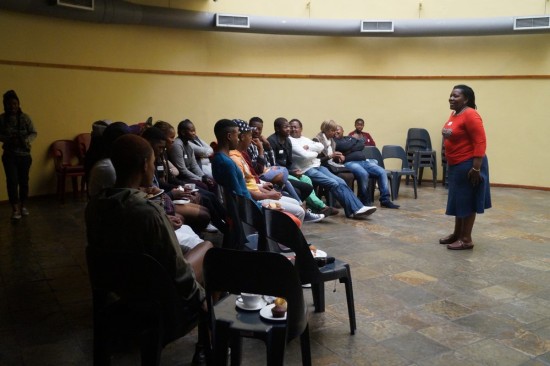

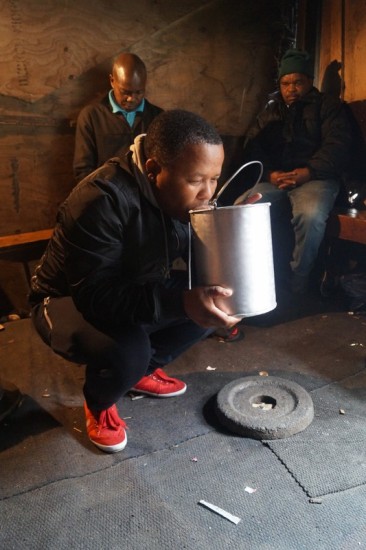
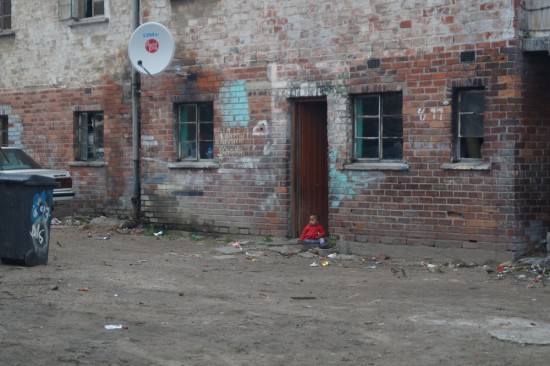

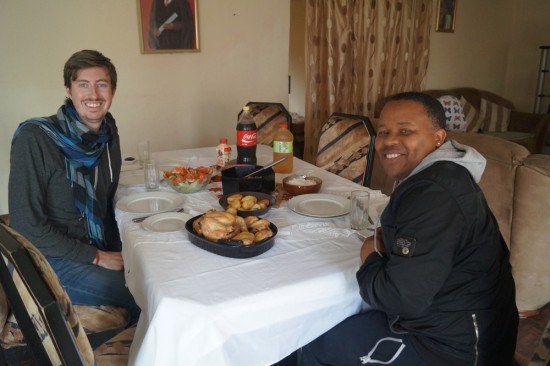
[…] We loved our time in Morocco and hope to come back in the future, but we were definitely ready for the next leg of our ‘Around the World’ adventure – South Africa! […]
[…] Continue along our ‘Around the World’ adventure – Next stop – South Africa! […]
[…] time in greater Cape Town was split into two parts: for the first 4 days, it was just the two of us. For the next 9 days, my mom and her husband Terry joined us. That seems like a natural way to […]